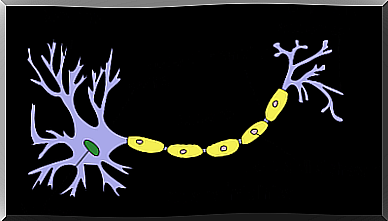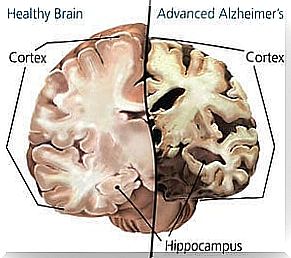What Happens To The Brain When Suffering From Alzheimer’s?

Unfortunately, we are used to hearing about different types of dementia, but we are not usually told clearly what happens to the brain when we suffer from these diseases. For this reason, the goal of our article today is to explain, in the simplest way possible, what happens to our brains when we are diagnosed with Alzheimer’s.
We will also talk about one of the most hopeful advances in Alzheimer’s treatment. This new discovery, recently published in the journal Nature , is so important that the results obtained could change the course of this disease as we know it today.
The brain and Alzheimer’s
When suffering from Alzheimer’s, severe degeneration of the brain occurs, especially of the hippocampus, of the entorhinal cortex, of the neocortex (in particular the area that connects the frontal and temporal lobes), of the basal ganglia, of the locus coeruleus and of the nuclei of the raphe.
However, what does this all refer to? We are talking about different areas of the brain which, explained in a simple way, contribute to the formation of learning, memory and emotional management. As you can see, all of these functions are highly impaired in Alzheimer’s patients.
And how does the degeneration of these areas take place? It is due to the development of senile plaques, or amyloid plaques, and of neurofibrillary clusters. However, before explaining what these plaques or clusters are, it is important to know what neurons are made of:
- Soma : is the central body of the neuron, in which its nucleus is located and all the information it receives from the other neurons that surround it.
- Axon : this is the largest protuberance that protrudes from the soma and which serves to send information from the neuron to all other neurons.
- Dendrites : they are the small extensions that come out from the central body of the neuron and that receive the information coming from the other neurons.

The senile plaques are deposits that are found outside the brain cells and that are composed of a nucleus whose protein is known as beta-amyloid. These deposits are surrounded by axons and dendrites which are in the process of degeneration. This degeneration is a natural process in any human brain and is therefore not pathological.
Furthermore, close to the senile plaques, we find active microgliocytes and reactive astrocytes, cells involved in the destruction of other harmful ones. Also involved are the so-called phagocytic glial cells, which are responsible for destroying the degenerated axons and dendrites, leaving only the beta-amyloid nucleus.
Nuerofibrillar clusters are composed of a dying neuron that contains an intercellular accumulation of interlocking strands of tau protein. Normal tau protein is a substance of microtubules, which represent the transport mechanism of the cell.
During the development of Alzheimer’s, an excessive amount of phosphate ions attaches to the tau protein, which changes its molecular structure. This structure transforms into a series of abnormal filaments that can be observed in the soma and the nearest dendrites of the cells of the cerebral cortex.
Furthermore, these ions alter the transport of substances inside the cell, which then dies and leaves a mass of protein filaments in its place.

Wait a minute, did we just say that neurons deteriorate? Yes, that’s right, and it’s a natural process of human aging. However, in the case of Alzheimer’s, the formation of amyloid plaques is due to the production of a defective form of beta-amyloid, which accelerates neuronal death, differentiating the process from that of normal aging.
This means that, as regards the plasticity that all brains have, in which there are neurons that degenerate, but that do not cause any damage or that are replaced by others, an alteration of this process is produced due to the plaques of beta-amyloid.
The importance of the new Alzheimer’s treatment
Recently, the journal Nature published an article titled Alzheimer’s disease: Attack on amyloid-β protein, written by Eric M. Reiman with collaborators. This article explains the discovery of new advances in the treatment of Alzheimer’s, especially on the subject of beta-amyloid protein.
Research by Reiman and his collaborators focuses on a new drug that prevents the destruction of neurons and the accumulation of amyloid protein plaques which, as we explained earlier, are considered a major cause of cognitive impairment in Alzheimer’s.
Félix Viñuela, neurologist and researcher at the Virgen Macarena Hospital in Seville, Spain, said that “this drug reaches the brain, joins the deposit of toxic substances and eliminates it from there.” In addition, “we have been able to see that a greater quantity of drug administered equates to a better recovery of the patients”.
However, the same researchers point out that, for now, this is a research conducted in 300 hospitals in North America, Europe and Asia, especially on patients with Mild Cognitive Impairment (MCI) and that, even if it is a progress very hopeful, there is still a long way to go for it to be used and to be able to demonstrate its long-term positive effects.









